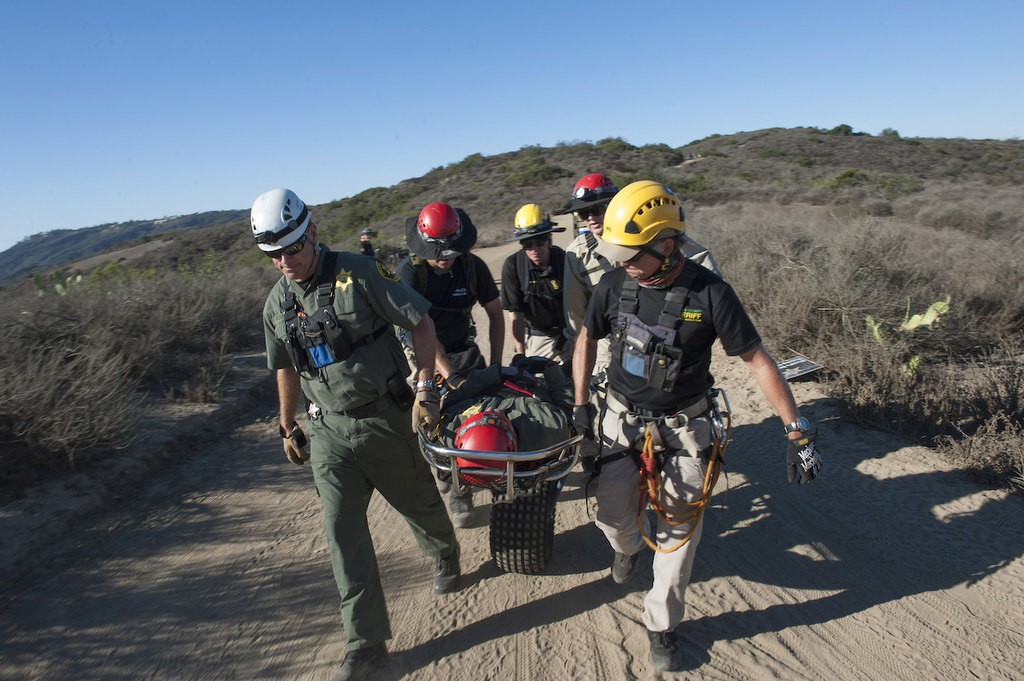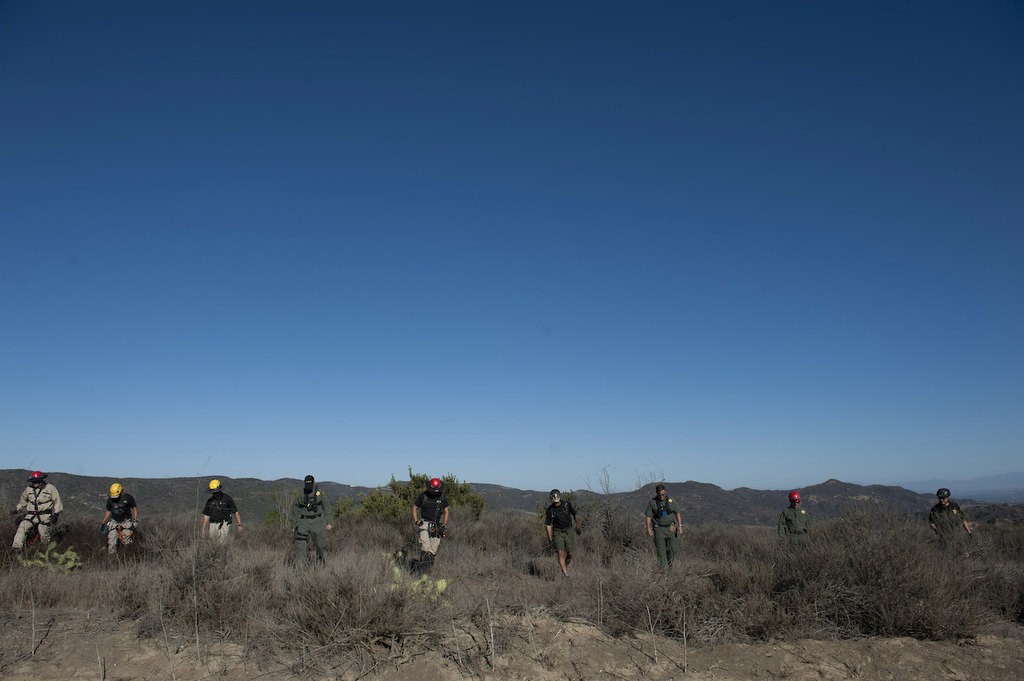When a call comes in – often in the late hours of the night – the team mobilizes.
“Whatever it is, we go day or night,” says Orange County Sheriff’s Department Reserve Lt. Devon Kemp, who helps lead the team of 50 volunteers making up the agency’s Search & Rescue Unit.
A combination of Reserve deputies and Professional Service Responders (PSRs), the team members have a wide range of day jobs – including attorneys, entrepreneurs and computer geeks.
Whatever their day job may be, when a call for a missing hiker comes in, they are ready to work – meaning they may have to take time off from their day job and even use vacation time.
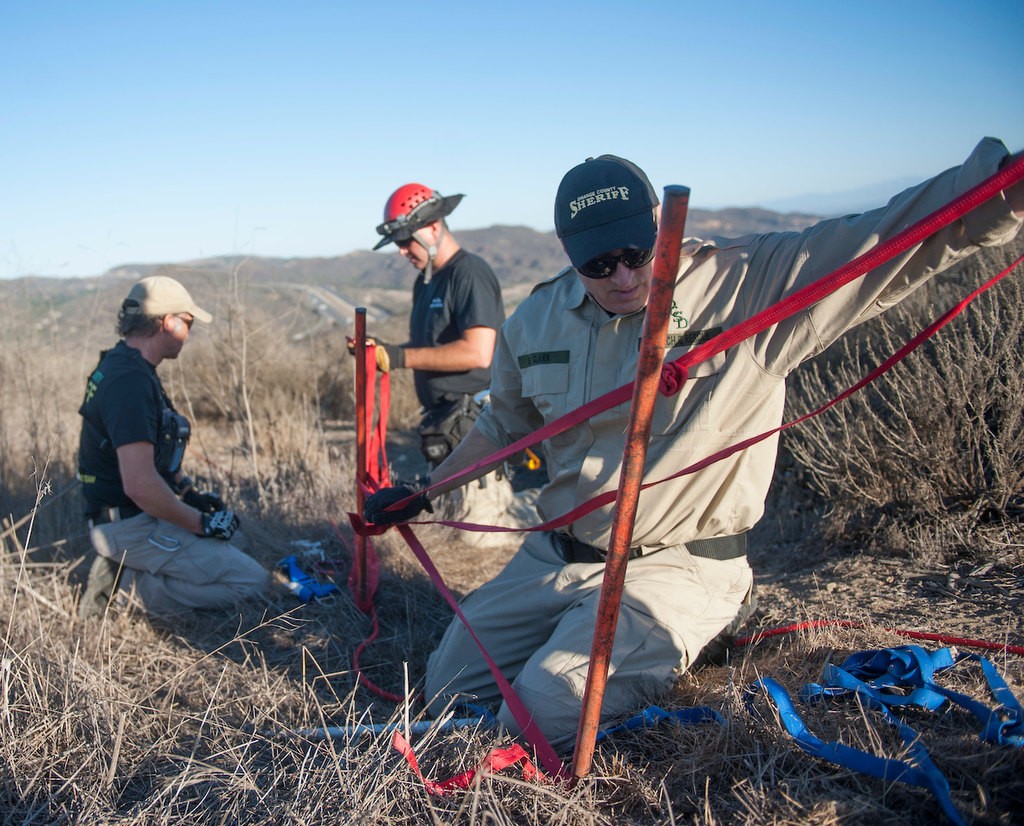
Members of the Orange County Sheriff’s Search and Rescue Team PSR (Professional Service Responders) Shawn Crawford, left, PSR Eric Klingsporn and PSR Brian Clark set up an anchor as part of a demonstration of the process of finding a lost subject in Aliso & Woods Canyons Wilderness Park. Photo by Miguel Vasconcellos
“The people who do this stuff have a huge heart just to help people,” says Reserve Capt. Chuck Williams, who heads up the Search & Rescue Unit.
A call may come in to the unit around 8 to 10 p.m., after the person is late coming home and law enforcement is alerted. Once the agency is notified of a missing hiker, the department commander (DC) calls the Search & Rescue team. The team will respond to the last known position of the hiker – which is usually the missing person’s car, says Kemp.
From that point, the team tries to determine the direction of travel (DoT) of the missing person.
“We’ll typically use bloodhounds to pick up the scent of the MP and trail the scent from the car,” he says. “We can also use human trackers to try and follow the footsteps of the MP.”

Members of the Orange County Sheriff’s Search and Rescue Team Deputy Gary Ziebarth, left, and Reserve Lt. Devon Kemp demonstrate the process of finding a lost subject on mountain bikes in Aliso & Woods Canyons Wilderness Park. The bikes allow for a quiet but quick search that allows them to hear responsive people off trail or a non-responsive person on a trail. Photo by Miguel Vasconcellos
Determining the direction of travel – while not required – is helpful to narrow down the search area.
“We typically try and search the areas of higher probability first, and then work our way to the lower areas,” says Kemp. “A DoT can help us determine the higher-level areas first.”
The next step is deploying the Hasty Teams, which quickly walk the trails looking for the missing hiker or any clues, like a backpack or other items belonging to the MP. The OCSD unit also uses two-person mountain bike rescue teams that can ride the trails quickly in search of the missing hiker or relevant clues.
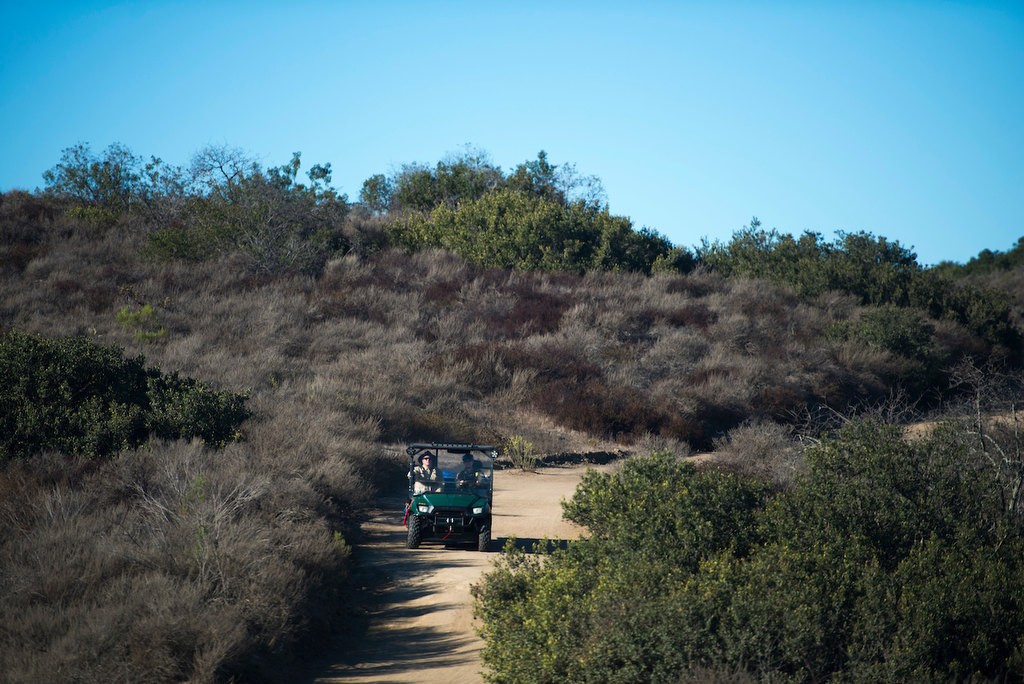
Members of the Orange County Sheriff’s Search and Rescue Team ride a fire trail in a Polaris off-road vehicle as they demonstrate the process of finding a lost subject in Aliso & Woods Canyons Wilderness Park. The Polaris allows for a fast search over steep terrain. Photo by Miguel Vasconcellos
“We can cover miles of single-track trail 10 times faster than hiking it,” says Kemp, a member of the mountain bike team.
Following the Hasty Teams are slower Ground Teams that perform a thorough search of the areas off the trail, according to Kemp. While Hasty Teams search for the missing hiker and clues on the trail, the Ground Teams search off the trails, under trees near trails, etc.
“As the search progresses we’ll bring in more and more teams that will search the lower probability areas and help saturate the higher probability areas,” Kemp says.
Once the missing person is found, the rescue phase begins.
“Depending on the situation, we may just walk them out, or sometimes if they’re stuck in a high-angle environment, my High-Angle Rescue Team will be assigned the task of rescuing them,” Kemp says. “If it’s a high-angle rescue, then my team will use ropes and a litter [similar to a stretcher]to reach the missing person and recover them from wherever they are.”
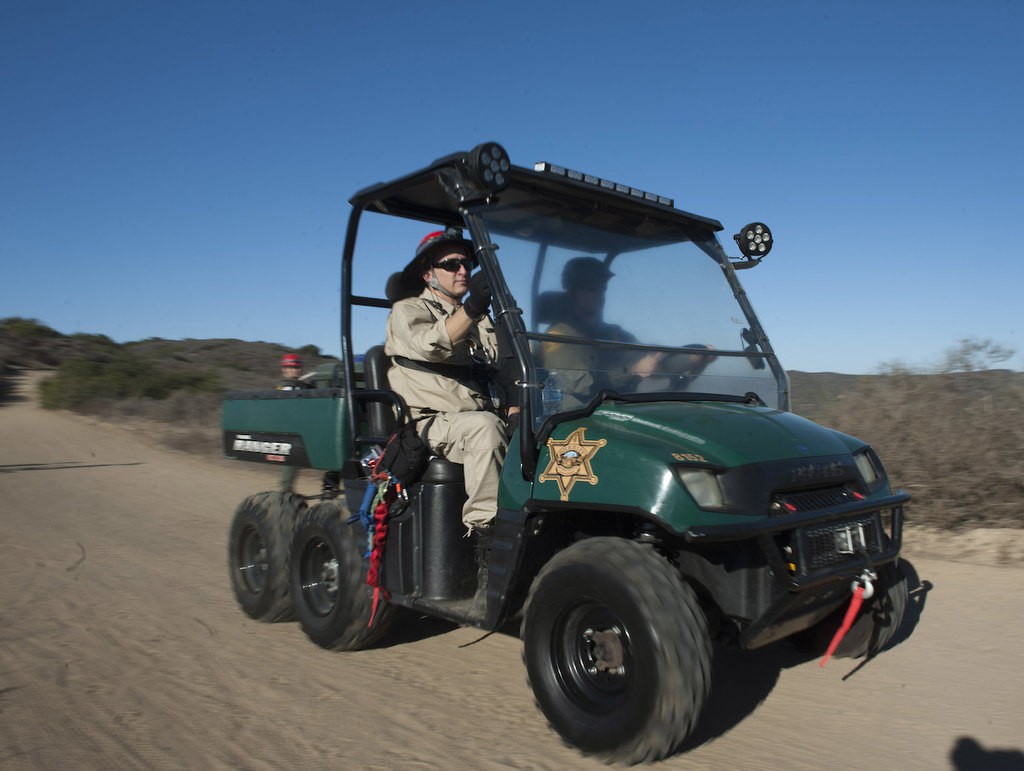
Members of the Orange County Sheriff’s Search and Rescue Team ride a fire trail down in a Polaris off-road vehicle. Photo by Miguel Vasconcellos
The larger unit holds monthly training sessions at remote wilderness areas to simulate rescues. The various squads and teams hold more frequent sessions to practice their particular skill set (for instance, mountain biking).
At a recent hiker rescue training session in a southern Orange County wilderness area, a smaller team of about a dozen went through a rescue scenario, including 95-pound bloodhound Reese and her handler Reserve Deputy Brenda Ortiz.
“A trail like this has lots of human scent,” says Ortiz. “If we give her a scent item, she will be able to distinguish that scent from other people on the trail.”
After sending Reese and the mountain bike team out, the “missing person” was found just off the trail. With the help of a picket of anchored rope that was then connected to the litter, the MP was pulled and rolled out onto the safety of the trail by two teams.
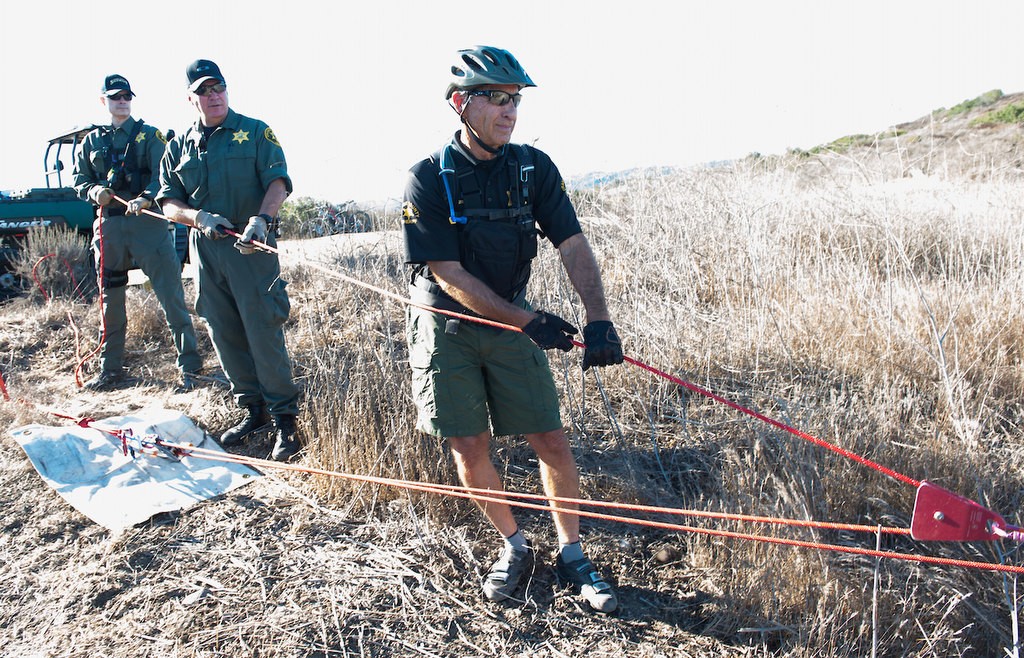
Members of the Orange County Sheriff’s Search and Rescue Team Sgt. Michael Geoghan, left, Capt. Chuck Williams and Deputy Gary Ziebarth help to pull up a litter as they demonstrate the process of finding a lost subject in Aliso & Woods Canyon Wilderness Park. Photo by Miguel Vasconcellos
According to Williams, so far this year the unit has been deployed about twice a month in search of missing hikers.
“We’re a resource for the department commander when somebody’s missing,” he says.
They will go out to wilderness parks and canyons all over Orange County, and also assist other agencies outside the area – in the heat and in the cold, and at all hours. Though rescues are typically in wilderness areas, the team also performs urban searches for missing Alzheimer’s patients and in situations where buildings have collapsed. They will also assist on evidence searches for things like casings from shootings.
In addition to the rescues, the unit also gets out to the trails to help prevent potentially dangerous situations.
“We do a preventative search and rescue,” says Kemp.
They’ll drive out in a Polaris off-road vehicle (which is also used in rescues) and hand out water to hikers and cyclists, to try and intercept problems before they start, says Williams. Sometimes people are lost and a SAR member will help them find their way back to their car. Or they’re getting dizzy from the heat.

Members of the Orange County Sheriff’s Search and Rescue Team show the process of a medium angle extraction by pulling a litter from the brush in a demonstration of finding a lost subject in Aliso & Woods Canyon Wilderness Park. Photo by Miguel Vasconcellos
“We’ll get out there and make contact before they get into an emergency situation,” Kemp says.
The unit runs like a well-kept machine. The training shows, and so do the friendships.
“There’s a pretty tight camaraderie in this kind of unit,” says Williams.
 Behind the Badge
Behind the Badge

